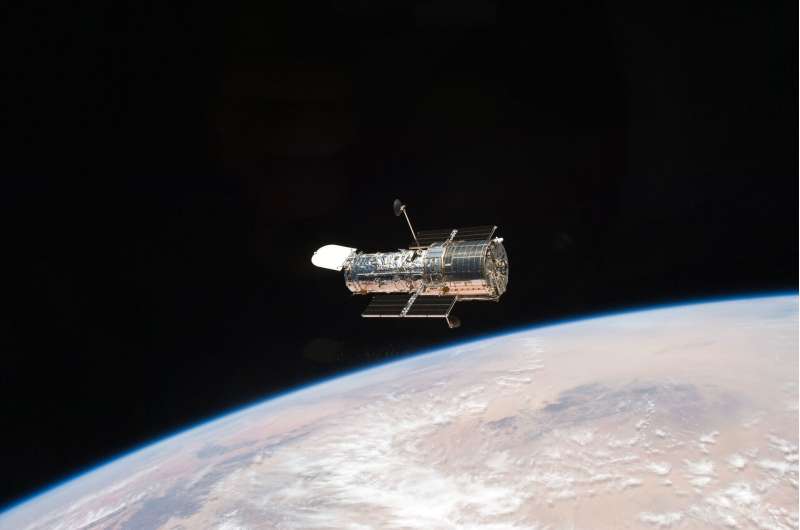The instrument has now been safely recovered. Standard calibration of the instrument and other pre-observation activities will be conducted this week. WFC3 observations will then be included in the science timeline so that the instrument can once again collect data and continue expanding our understanding of the universe.
Mar. 12, 2021—NASA's Hubble Space Telescope Resumes Science Operations
The Hubble Space Telescope returned to science operations on Thursday, March 11 at 8:00 p.m. EST. Wide Field Camera 3 remains suspended while the team investigates a low voltage issue that prevented it from returning to operations. The telescope has completed its first observation since returning to science mode, using the Cosmic Origins Spectrograph instrument to map gas flows in active galactic nuclei.
Mar. 11, 2021—NASA's Hubble Space Telescope Set to Resume Science Operations
NASA is working to return the Hubble Space Telescope to science operations after resolving a problem with a safeguard aboard. Hubble entered safe mode on Sunday, March 7, shortly after 4 a.m. EST, following detection of a software error within the spacecraft's main computer.
The spacecraft has been moved out of safe mode into a pre-science state with the plan of returning to normal operations by Thursday night.
Safe mode puts the telescope into a stable configuration until solutions can be implemented from the ground to correct a problem and return the mission to normal operations. There are varying versions of safe mode depending on the problem encountered.
The mission operations team at NASA's Goddard Space Flight Center identified the software error in an enhancement recently uploaded to the spacecraft to help compensate for fluctuations from one of its gyroscopes. These devices are used to help Hubble turn and lock on to new targets by measuring the speed at which the spacecraft is turning. They determined that the enhancement did not have permission to write to a specific location in computer memory, which caused an issue with the main flight computer and subsequently caused the spacecraft to enter a safe mode.
The team will update the software enhancement so the fix can be uploaded to the spacecraft in the future. In the meantime, the enhancement will be prohibited from being used.
In entering safe mode on Sunday, however, the team discovered that the aperture door located at the top of the telescope failed to automatically close. This door is a safeguard designed to keep the Sun's damaging light and heat out of the telescope's interior, protecting its sensitive instruments and their surroundings. It serves as a safety net if Hubble accidently points in the direction of the Sun due to an error or hardware problem. In more than 30 years Hubble has been in orbit, the aperture door has never closed because of the detection of such bright objects.
The team has looked at spacecraft engineering data, run various tests, and verified that the door did indeed remain open despite the commands and power being sent to close it. Additional attempts to move the door by sending commands from the ground to its primary motor also failed to make the door move. However, the same commands sent from the ground to its backup motor did indicate movement, and that motor is now set as the primary motor. The team is looking at options to further reduce any associated risk.
During the process of moving the spacecraft into its pre-science state, the Wide Field Camera 3 instrument experienced an unexpected error, suspending it from returning to operations. The team is currently reviewing that issue and possible solutions.
All other instruments have been recovered with no issues. Hubble will be returned to science operations Thursday night, with no Wide Field Camera 3 observations scheduled until the team resolves that issue.
Hubble's instruments are expected to produce groundbreaking science for years to come.
Explore further



